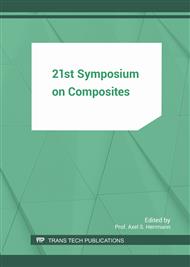p.358
p.366
p.374
p.381
p.389
p.395
p.401
p.408
p.419
Polyelectrolyte Treatment of Cellulose Fibers for the Manufacture of Novel Bio-Hybrid Fiber Composites (Bio-HFC) for Lightweight Applications
Abstract:
In this study flax fabrics were treated with polyethylene imine (PEI) and afterwards, in combination with carbon fabrics, integrated into epoxy resin via vacuum infusion process. The influence of the 2 stacking sequences of the fabrics and 2 PEI concentrations were evaluated with regard to the mass fractions of the composite components and mechanical properties of the manufactured composites, namely, flexural and interlaminar shear properties. The results showed that the effect of the surface treatment is dependent on the stacking sequence. Namely, increase of the PEI concentration resulted in a corresponding increase of the mass fraction of the polymer matrix in the case of interchanging arrangement of flax and carbon fabrics. Further remarkable results showed that the same specimen provided the highest values of the supported maximum load after the surface treatment. Influence of the PEI treatment on the strength values with regard to the stacking sequence and polyelectrolyte concentration led to controversial results. Decrease of flexural modulus after the surface treatment was observed in the case of all samples.
Info:
Periodical:
Pages:
389-394
Citation:
Online since:
July 2017
Authors:
Keywords:
Price:
Сopyright:
© 2017 Trans Tech Publications Ltd. All Rights Reserved
Share:
Citation:


